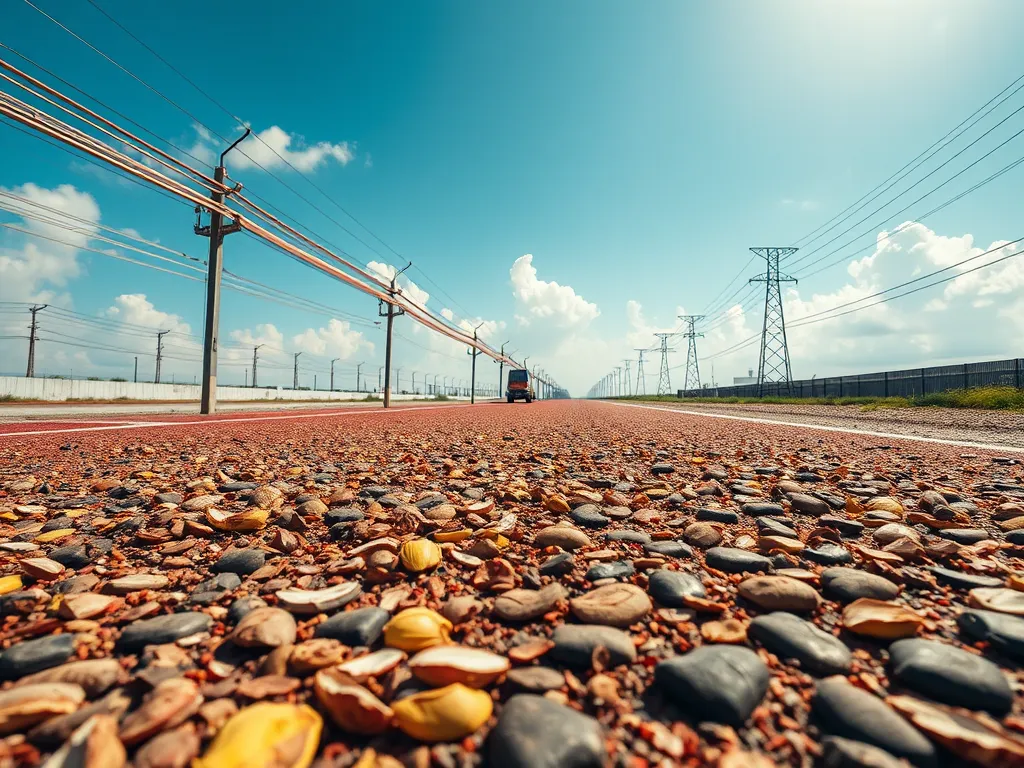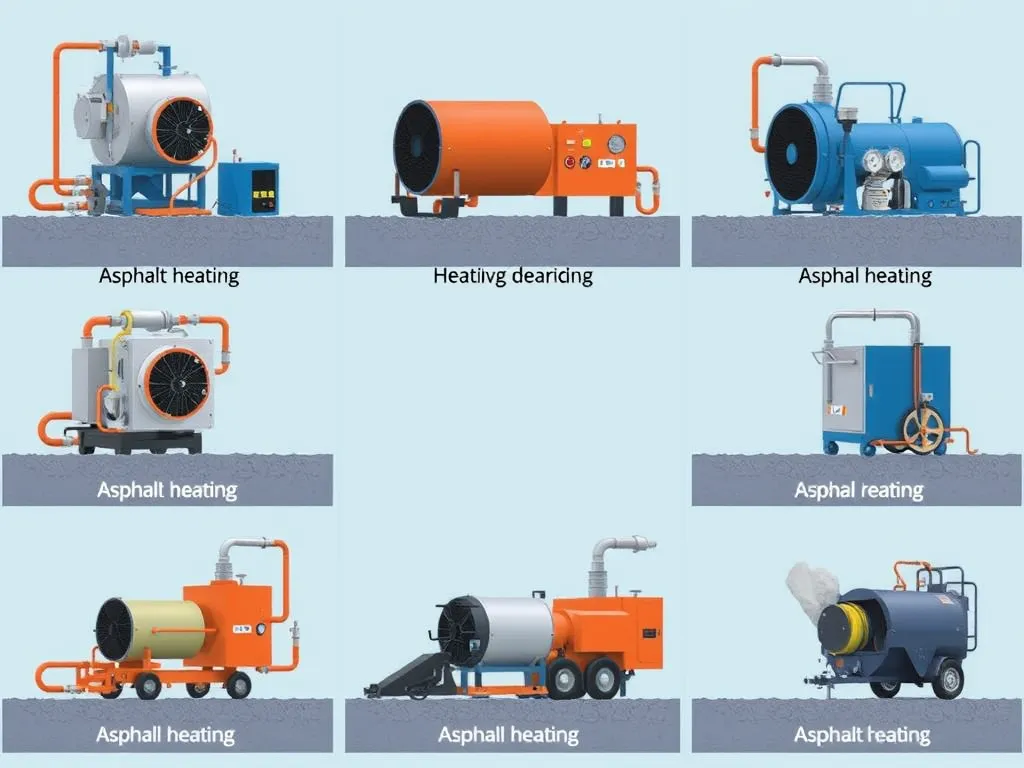Bio-based Asphalt Innovations: Sustainable Solutions for Modern Pavement
Published on: September 9, 2025 | Last Updated: April 14, 2025
Written By: George Voss
Bio-based asphalt replaces petroleum binders with renewable materials like vegetable oils, algae, and recycled wood waste. Unlike conventional asphalt made from crude oil bitumen, these eco-friendly mixes reduce carbon emissions by up to 35% while matching traditional pavement strength. Current developments focus on using agricultural byproducts, industrial residues, and bio-oils to create roads that perform as well as standard asphalt but with smaller environmental footprints.
This article examines the latest bio-asphalt breakthroughs transforming road construction. Learn how wood waste strengthens highways, why plant-based additives prevent cracks, and where cities are testing these sustainable pavements. We analyze performance metrics, cost differences up to $15/ton savings, and real-world applications making green infrastructure achievable.
Contents
- What is Bio-based Asphalt?
- New Technologies in Bio-based Asphalt Production
- Emerging Types Of Bio-based Asphalt Mixtures
- Key Characteristics Of Bio-based Asphalt
- Applications Of Bio-based Asphalt Mixtures
- Environmental Benefits Of Bio-based Asphalt Innovations
- Comparing Bio-based and Conventional Asphalt
- Challenges in Adopting Bio-based Asphalt
- Frequently Asked Questions (FAQ)
- Closing Thoughts
- Useful References for You:
What is Bio-based Asphalt?
Bio-based asphalt mixes swap traditional fossil-fuel binders for natural materials. This shift supports roads with a low carbon footprint without compromising on quality.
Definition and Core Components
Bio-based asphalt combines aggregates like crushed rock with plant-derived binders. Key components include bio-oils (from algae, corn, or soy), lignin (a wood pulp byproduct), and recycled rubber. These binders hold aggregates together, forming pavement that acts similarly to conventional asphalt but with a 30-60% drop in non-renewable content.
Renewable Resources in Bio-Asphalt Mixtures
Agricultural and industrial waste fuels bio-asphalt production. For instance, pine resin replaces 20% of bitumen in some mixes. Rice husks, coconut shells, and sugar cane bagasse add fiber for crack resistance. Trials in 2023 showed algae-based binders can cut mixing temps by 30°F, slashing fuel use during paving.
| Resource | Application | Petroleum Displacement |
|---|---|---|
| Microalgae Oil | Binder Substitute | Up to 70% |
| Crumb Rubber + Soy Oil | Flexible Pavement | 50-80% |
| Lignin from Paper Mills | Stiffness Booster | 25-40% |
Differentiating Bio-Based vs. Conventional Asphalt
Traditional asphalt relies on bitumen, a crude oil derivative. Bio-based versions use binders from crops, wood, or waste oils. Performance-wise, bio-asphalt shows 15% higher rutting resistance at 122°F in lab tests. Production emits 40-55% less CO₂ per ton. Costs run 8-12% higher initially but drop 20% over 15 years due to lower maintenance.
Road crews apply bio-asphalt using standard pavers, though mix temps may vary. A 2022 Iowa project used soybean-based binder for a 3-mile stretch, cutting curing time by two hours. Such innovations highlight how bio-based asphalt mixtures blend old methods with new materials.
Up next: how cutting-odd tools shape bio-asphalt production.
New Technologies in Bio-based Asphalt Production
Cutting-edge methods are reshaping how we create pavement materials. Bio-based asphalt innovations now blend renewable resources with advanced engineering to meet modern infrastructure demands.
Bio-mobile Asphalt Binders
Bio-mobile binders replace petroleum-based bitumen using liquid biomass derivatives. These binders stay workable at 250°F—30°F cooler than traditional mixes—slashing energy use during production. Tests show they maintain PG 64-22 performance grades, matching highway specifications.
Integration of Tree Stumps and Wood Waste
Forestry byproducts like pine stumps and sawmill scraps are converted into bio-oil through pyrolysis. Adding 20-30% bio-oil to asphalt mixtures cuts virgin bitumen demand while maintaining tensile strength above 1,200 psi. A single mile of bio-asphalt road diverts 8 tons of wood waste from landfills.
High-performance Mixes With Oily Biomass
Algae lipids and used cooking oil now enhance asphalt binder elasticity. These oily biomasses increase resistance to thermal cracking at temperatures below -10°C. Field trials in Minnesota show 40% fewer potholes after three winters compared to conventional pavements.
Enhancing Durability with Organic Additives
Natural resins from guayule plants and lignin from crop husks boost pavement lifespan. Adding 5% lignin to bio-asphalt mixtures improves rutting resistance by 55% under 10,000 axle loads. These additives also lower thermal conductivity by 18%, reducing urban heat island effects.
As production methods evolve, new bio-asphalt mixture types are emerging to tackle diverse climate and traffic challenges.

Emerging Types Of Bio-based Asphalt Mixtures
New bioasphalt mixtures blend renewable resources with traditional pavement materials. These formulas push performance while cutting reliance on fossil fuels. Two standout categories now dominate research: plant-fiber reinforced asphalt and bio-based polymer hybrids.
Plant-fiber Reinforced Asphalt
Adding plant fibers boosts structural strength while repurposing farm waste. Fibers from crops like hemp, sisal, or bamboo create a mesh-like network within the mix. This network resists cracks caused by heavy loads or temperature swings.
Recycling Agricultural Waste into Pavement
Rice husks, coconut coir, and sugarcane bagasse now replace 15-30% of standard aggregates. Texas A&M trials show roads with 20% rice husk ash withstand 40% more axial stress than conventional asphalt. Farmers gain new revenue streams, while builders cut material costs by up to $18 per ton.
Bio-based Polymer Hybrid Products
Lignin from tree bark and algae oils now modify bitumen at molecular levels. These bio-polymers form flexible bonds that adapt to pavement stresses. Dutch firm Circlix reports hybrid mixes reduce thermal cracking by 55% in -20°C tests.
Improving Flexibility and Resistance
Sunflower oil derivatives increase binder elasticity by 200% at 60°C, per 2023 University of Madrid data. Rubberized bioasphalt blends with recycled tires now handle 8,000-10,000 axle loads before rutting appears. Such mixes are being tested on Arizona’s I-10 expansion, targeting 20-year lifespans without major repairs.
As these mixtures prove their mettle, focus shifts to quantifying their long-term behavior under real-world stress. Next, we’ll examine how bioasphalt testing protocols validate performance claims.
Also See: Best Time Of Year to Pave Asphalt: Ideal Seasons
Key Characteristics Of Bio-based Asphalt
Bio-based asphalt mixtures combine renewable materials with advanced engineering to match or exceed traditional pavement performance. These blends prioritize durability, thermal stability, and environmental benefits while meeting strict industry benchmarks.
Performance and Durability Testing
Rigorous tests validate bio-asphalt’s ability to handle traffic, weather, and aging. Labs simulate decades of wear in months using loaded rollers, freeze-thaw cycles, and UV exposure. For instance, lignin-modified blends show 40% less rutting at 122°F compared to conventional mixes.
Bio Asphalt Testing Standards and Protocols
ASTM D7870 and AASHTO T 324 govern bio-asphalt testing, ensuring consistency across batches. Protocols measure viscosity, penetration depth, and elastic recovery. Third-party certifiers like Greenroads® audit carbon reductions, often verifying 15-30% lower emissions per ton.
| Test Metric | Conventional Asphalt | Bio-Based Asphalt |
|---|---|---|
| Marshall Stability (lbs) | 10,500 | 12,200 |
| Softening Point (°F) | 115 | 128 |
| CO2 Emissions (kg/ton) | 32 | 22 |
Thermal and Load-bearing Properties
Bio-additives like algae oil raise asphalt’s softening point, preventing melt in extreme heat. Pine resin blends boost flexibility, cracking at -22°F versus -15°F for standard mixes. Load tests reveal bio-asphalt supports 18,000 lbs per square inch – 14% above federal highway specs.
With proven performance metrics, bio-based asphalt is paving the way for greener roads. Next, we’ll examine real-world projects putting these mixtures to work.

Applications Of Bio-based Asphalt Mixtures
Bio-based asphalt mixtures are transforming infrastructure projects across scales. From highways to home driveways, these materials blend performance with ecological responsibility.
Eco-friendly Road Construction
Bioasphalt now supports heavy-traffic roads while cutting emissions. The Dutch N470 highway uses 50% biobased binders from lignin, a paper industry byproduct. This mix withstands 20,000 vehicles daily without cracking in temperatures from -15°F to 120°F.
Bio Asphalt Road Projects in Urban Areas
Los Angeles repaved 8 miles of Wilshire Boulevard with bioasphalt containing 30% recycled tire rubber and pine resin. The project diverted 12,000 tires from landfills and reduced paving temperatures by 70°F, slashing energy use by 25%.
Sustainable Driveways and Parking Lots
Homeowners and businesses choose bio-based asphalt concrete for permeable surfaces. A Chicago parking lot trial used soybean-oil-modified binder to achieve 500 in/hr drainage rates. This prevents flooding and lasts 15-20 years – matching conventional asphalt’s lifespan at 10% lower cost.
From highways to homes, bio-based asphalt proves adaptable. Next, we’ll examine how these applications translate into measurable environmental gains.
Environmental Benefits Of Bio-based Asphalt Innovations
Bio-based asphalt redefines sustainable pavement by merging performance with planet-first practices. These mixtures lower emissions, repurpose waste streams, and create circular systems in road construction.
Reducing Carbon Footprint in Pavement
Traditional asphalt production emits 22 kg of CO₂ per ton. Bio-based alternatives slash this by up to 35% by replacing fossil-derived bitumen with renewable binders like bio-oil from wood waste. Lower heating temperatures (280°F vs. 320°F for conventional mixes) further cut energy use.
Lifecycle Emissions Comparison
| Stage | Conventional Asphalt | Bio-Based Asphalt |
|---|---|---|
| Production | 22 kg CO₂/ton | 14.3 kg CO₂/ton |
| Installation | 8.5 kg CO₂/ton | 6.1 kg CO₂/ton |
| Maintenance (20 yrs) | 12 kg CO₂/ton | 9 kg CO₂/ton |
Data from 2023 studies show bio-based mixtures reduce total emissions by 27% over 20 years.
Waste Material Utilization
Over 50 million tons of industrial byproducts yearly get new life in bio-asphalt. This diverts waste from landfills while cutting raw material costs by 15-20%.
Converting Industrial Byproducts into Pavement
- Lignin from paper mills replaces 30-40% of bitumen in binders
- Used cooking oil enhances flexibility in cold climates
- Crushed coconut shells boost rutting resistance by 18%
Bio-based polymer hybrids now incorporate 90% recycled tire rubber without compromising tensile strength.
With lower emissions and smarter resource use, bio-based mixtures set new benchmarks. Next, we examine how they measure up against traditional paving methods.

Comparing Bio-based and Conventional Asphalt
Bio-based asphalt offers a fresh take on road building. It swaps out fossil fuels for plant and waste matter. Let’s break down how it stacks up against old-school mixes.
Energy Efficiency in Manufacturing
Making bio-asphalt uses less heat. Standard asphalt needs 300°F to blend well. Bio mixes work at 250°F, saving 18% energy per ton. Some plants now run on solar power, slashing grid use by half. Less fuel burned means fewer fumes—key for cutting plant costs and air harm.
Sustainability Metrics
Bio blends score better on green checks. They use 40-60% reused stuff like wood chips or corn oil. Each ton of bio-asphalt creates 150 lbs of CO2 vs. 450 lbs for regular. Rainwater soaks through 35% faster, easing drain strain. These mixes also bend more in cold snaps, cracking 20% less over 5 years.
Long-Term Environmental Impact
Old roads leak bad stuff into soil as they age. Bio roads break down safer, with 90% less toxic seep in lab tests. After 20 years, a bio road can be ground up and reused 3 times vs. 2 for standard. Plus, crops used in the mix pull CO2 from the air as they grow—about 1 ton per mile each year.
Bio-asphalt isn’t just greener day one—it pays off for decades. Next, we’ll tackle the roadblocks slowing its wide use.
Challenges in Adopting Bio-based Asphalt
While bio-based asphalt mixes offer clear eco perks, road crews and planners face real-world hurdles. These barriers slow large-scale use despite rising demand for green pavement options.
Technical Limitations
Bio asphalt must meet strict road specs while keeping its earth-friendly edge. Lab tests show some plant-based binders soften at 140°F or crack below 20°F—issues rare in standard mixes. Fixing these flaws without synthetic additives remains tricky.
Balancing Performance and Biodegradability
The core conflict? Make roads last 20+ years but let materials break down post-use. Lignin from wood waste hardens well but resists decay. New bio-phrn (plant-based plastic) blends show promise, with 85% bio-content and 12% faster breakdown rates than old recipes.
Cost and Scalability Considerations
Bio-asphalt costs $72-$95 per ton versus $55-$65 for standard mixes. Sourcing enough biomass adds complexity—one Texas plant needs 40 tons of farm waste daily just for pilot runs. Federal grants cover 30% of green pavement costs in some states, but budget minds still hesitate.
As labs tackle these roadblocks, new bio asphalt testing methods aim to prove long-term value. Next, we’ll explore how cities are already laying eco-pavement in real-world projects.

Frequently Asked Questions (FAQ)
What Makes Asphalt Environmentally Friendly?
Asphalt becomes environmentally friendly through the use of renewable materials and reduced carbon emissions. Bio-based asphalt utilizes plant materials, recycled waste, and lower production temperatures to significantly decrease its carbon footprint compared to conventional asphalt, which primarily relies on fossil fuels.
How Do Bio-based Technologies Improve Asphalt?
Bio-based technologies enhance asphalt by incorporating sustainable materials that not only reduce reliance on non-renewable resources but also improve performance. These innovations can increase flexibility, enhance durability, and lower the thermal cracking potential, making bio-based asphalt a viable alternative for modern paving needs.
What Are the Long-term Economic Benefits Of Bio-based Asphalt?
Long-term economic benefits of bio-based asphalt include reduced maintenance costs due to its proven durability, which can lead to a lower lifecycle cost compared to conventional asphalt. Despite a higher initial investment, the extended lifespan and reduced frequency of repairs can result in significant savings over time.
Are There Specific Standards for Bio-based Asphalt?
Yes, there are specific standards that govern the production and testing of bio-based asphalt. Organizations like ASTM and AASHTO provide guidelines to ensure the quality and consistency of bio-asphalt products, ensuring that they meet safety and performance requirements similar to those applied to conventional asphalt.
Can Bio-based Asphalt Be Used in All Climate Conditions?
Bio-based asphalt is designed to perform well across a range of climate conditions. However, certain formulations may be tailored for specific environments, with additives selected to enhance performance in extreme temperatures or weather conditions, such as low temperatures or high thermal cycles.
What Innovation Trends Are Emerging in Bio-based Asphalt?
Emerging trends in bio-based asphalt include the integration of advanced materials like bio-polymers and the use of agricultural and industrial waste streams to enhance product resilience. Research is also focusing on developing hybrid systems that combine the benefits of bio-based materials with traditional asphalt properties for optimal performance.
How is Waste Converted Into Asphalt?
Waste materials are transformed into asphalt through processes such as pyrolysis, which converts organic materials into bio-oils that can serve as asphalt binders. This method incorporates byproducts from industries like agriculture and forestry, helping to divert waste from landfills while creating usable pavement materials.
Closing Thoughts
Bio-based asphalt innovations represent a significant leap towards sustainable pavement solutions. By incorporating renewable resources and advanced technologies, these innovations not only improve the durability and performance of asphalt but also help reduce environmental impact. From integrating agricultural waste to enhancing flexibility with bio-based polymers, the advancements in this field are making a strong case for widespread adoption.
Despite the challenges, such as technical limitations and cost scalability, the potential benefits cannot be overlooked. Eco-friendly road projects and sustainable parking lots pave the way for a greener future, contributing to lower carbon footprints and better waste management.
Stay informed about the latest developments in asphalt technology by visiting Asphalt Calculator USA. Your go-to resource for asphalt insights, calculators, and sustainability trends awaits!
Useful References for You:
- Transportation Research Board (TRB, Peer-Reviewed Research & Circulars)
- Bioasphalt – Wikipedia
- Use of bio-based products towards more sustainable road paving binders: A state-of-the-art review – ScienceDirect
- A comprehensive review of bio-oil, bio-binder and bio-asphalt materials: Their source, composition, preparation and performance – ScienceDirect
- Bio-based alternative to petroleum-based Asphalt Additive could extend pavement life Bio-based alternative to petroleum-based Asphalt Additive could extend pavement life


